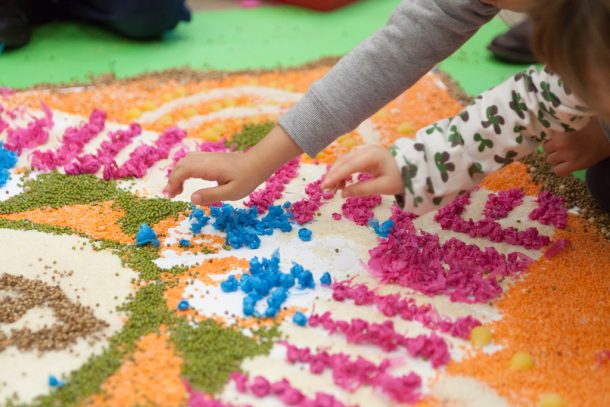Let’s celebrate Diwali!
Diwali is an enchanting Hindu festival that celebrates the victory of light over darkness and good over evil. Diwali is similar to New Year celebrations, and means a new beginning – a time when people wear their best clothes and clean their houses. They decorate places with flowers and small oil lamps called diyas. Families welcome guests with beautiful patterns made out of coloured sand or rice, called Rangoli. They also enjoy fireworks, presents and sweets!
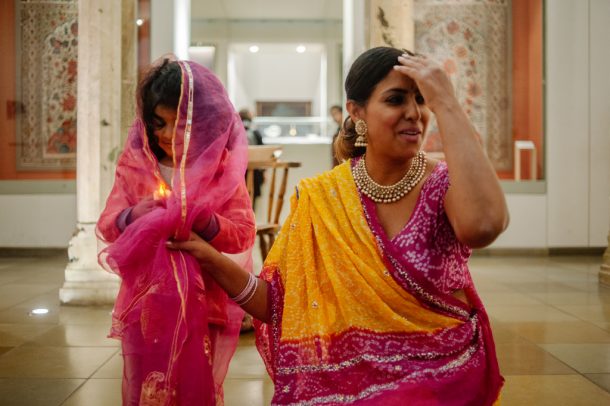
Let’s find out where the name ‘Diwali’ came from
Did you know that Diwali means ‘a row of lighted lamps’? Read about the story of Diwali to learn why.
Once upon a time there was a great warrior, Prince Rama. He had a beautiful wife named Sita. There was also a terrible demon king, Ravana. He had 20 arms and 10 heads and was feared throughout the land. You can see Rama, Sita and Ravana in the images below. Can you tell who is who? A little hint: Rama is blue as a symbol of his depth and purity, just like the ocean or the sky.
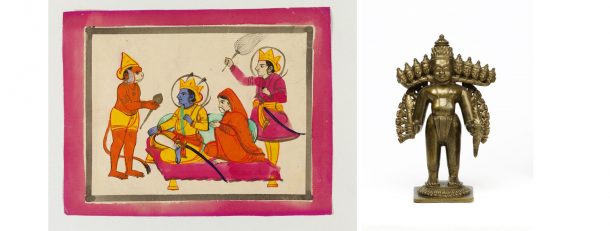
Ravana wanted Sita to himself. One day he kidnapped her and took her away in his chariot. Clever Sita left a trail of her jewellery so that Rama could find her. Following the jewellery trail, Rama met the monkey king, Hanuman who agreed to help find Sita. Messages were sent to all the monkeys and bears in the world. They all set out to look for Sita.
After a very long search, Hanuman found Sita imprisoned on a remote island. Rama’s army of monkeys and bears couldn’t reach the island, so they began to build a bridge. Soon all the animals of the world, large and small, came to help. When the bridge was built, they rushed across it and fought a mighty battle.
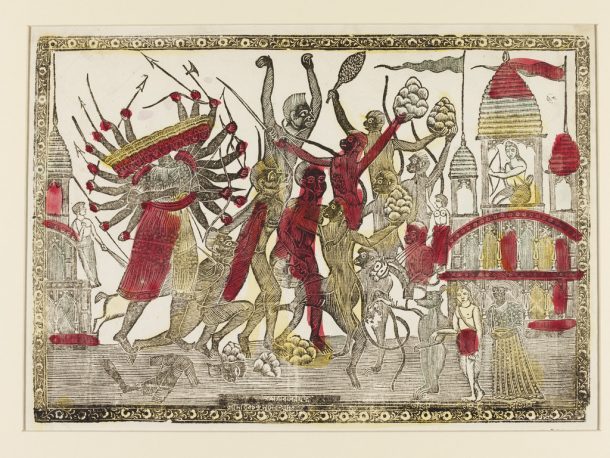
When Rama killed the evil Ravana with a magic arrow, the whole world rejoiced. Rama and Sita began their long journey home. Everybody lit oil lamps to guide them on their way and welcome them. Ever since, people light lamps during Diwali. They remind themselves that light triumphs over dark and good triumphs over evil.
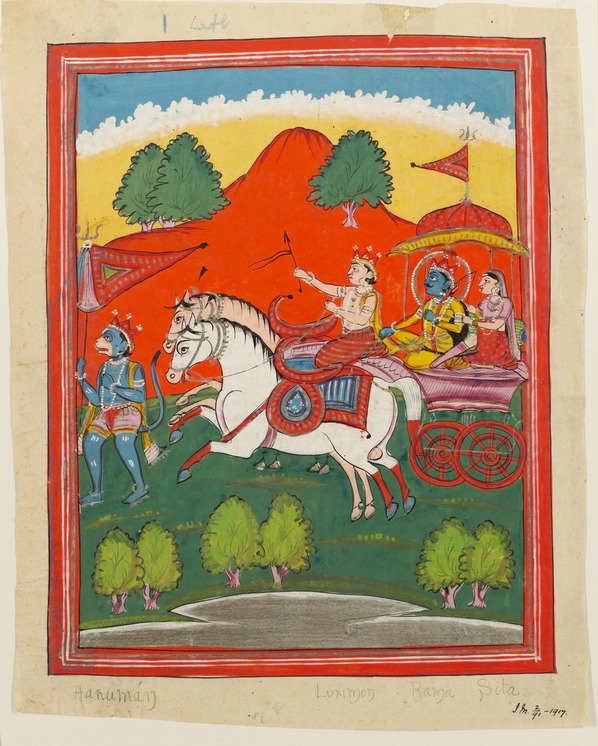
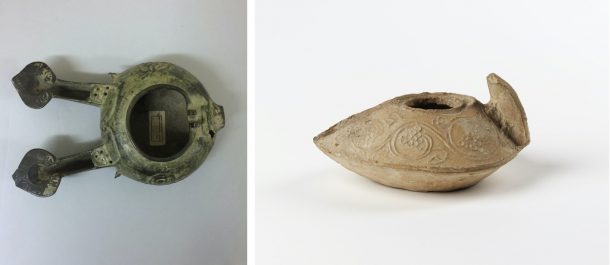
Let’s make a sensory Diya Lamp from salt dough!
To make 1 lamp you will need:
- 250g of plain flour
- 125g of salt
- 125ml of water
- Grease proof paper
- A baking tray
- A LED tea light or candle (only use a candle if you’ve got an adult helping)
- Ground spices (such as cinnamon or turmeric) to mix with the dough for smell and colour
- Objects you find around the house to imprint a pattern into the dough
- Whole spices (such as cardamon or mustard seeds, star anise or cloves) to decorate your lamp
- Paints, brushes, felt tips and other things to finish your diya lamp design.
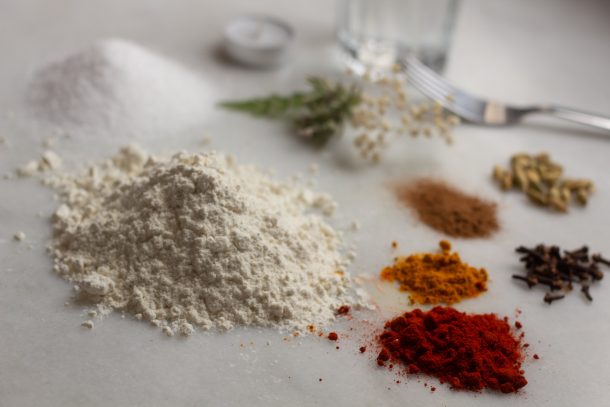
Let´s get started! Please work with an adult when using the oven.
- Heat the oven to 100C degrees and put grease proof paper on a baking tray.
- Mix the salt and flour in a bowl. Add the water and stir until it comes together.
- Transfer the dough to a floured surface.
- Work in the ground spices to add colour and smell. Be careful not to stain your clothes if you’re using turmeric!
- Mould your dough into a lamp shape. It should be big enough to hold a tealight. Look at the two images above of lamps from the V&A collection to get ideas.
- Add decorative patterns to your diya lamp design using objects from your home (like fork teeth or twigs). Explore the V&A’s India collections for pattern inspiration by watching this video.
- You could also add cardamon or turmeric seeds, star anise or cloves for more decoration.
- Place your lamp on to a tray with grease proof paper and bake for 1 hour or until solid.
- Leave to cool. If you like, use other materials such as paints or felt tips to finish your design.
Well done! Now you can display your diya lamp in the window or outside your door. It will help Rama and Sita to find their way home and brighten up the day for your neighbours and everyone who passes by. Be careful where you put your lamp if you’re using a candle, and ask an adult before you light it.
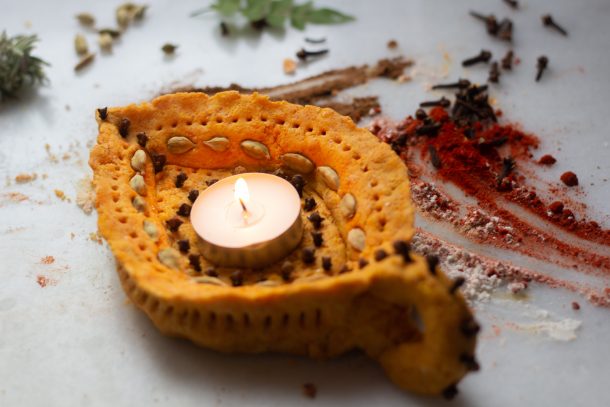
Let’s try something else – a rangoli design!
The word Rangoli means ‘row of colours’. It is a colourful pattern created on the floor from rice, powder or flower petals. People make Rangoli during Hindu festivals such as Diwali. They are sacred welcoming areas for Hindu gods.
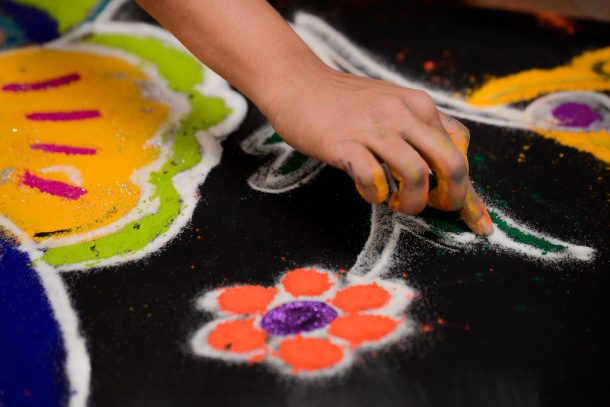
To make your own rangoli design:
- Find a sheet of white or colour paper or cardboard for a base, some pencils and glue. Then get some more coloured paper, some tissue paper or an old magazine with lots of images.
- Draw your own rangoli design on the paper or cardboard base to make a template using coloured pencils.
- Cover your pattern in glue.
- Start making little balls of coloured paper and stick them on top of your pattern.
- Are you up for a challenge? Use spices, rice and lentils instead of coloured paper to make your rangoli.
- Display your rangoli in the window or front door to share it with your neighbours.
Happy Diwali and don’t forget to share your designs with us on social media using #LetsMakeWednesdays.
